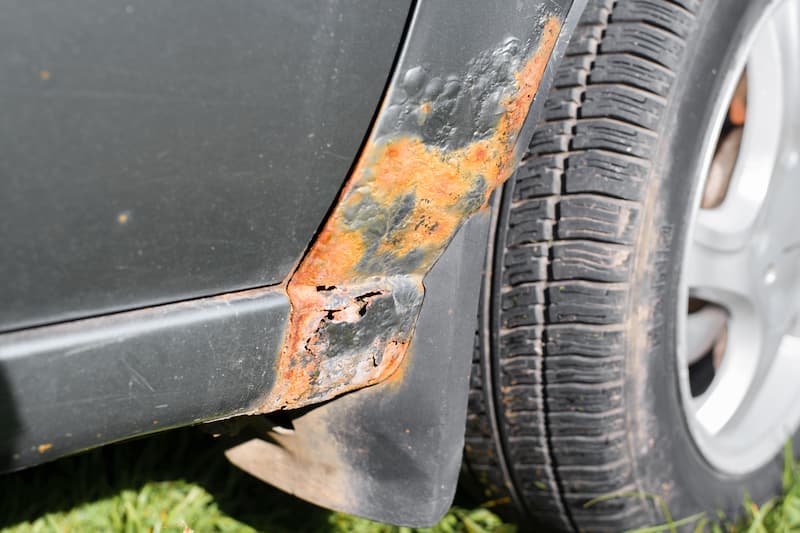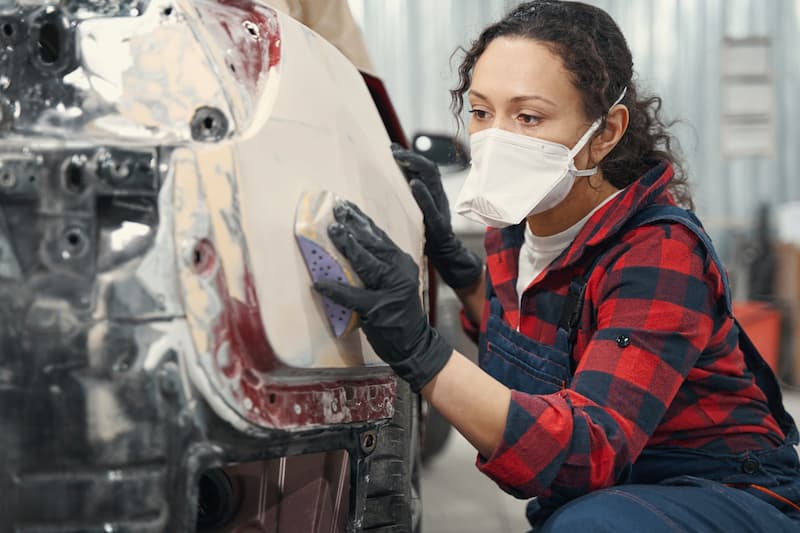No products in the cart.
Rust Converter for Automotive Rust Protection: Convert and Prime Cars for Lasting Results
September 25, 2024
By Xion Lab
Free Shipping
easy returns
secure paymentS
FAQ | MY ACCOUNT | SUPPORT
September 25, 2024
By Xion Lab
Rust is a common issue for vehicles, particularly in regions where winter road treatments like salt accelerate corrosion. Rust not only affects the appearance of your vehicle but can also lead to structural damage if not addressed. One of the most effective ways to combat rust is by using a rust converter, which chemically transforms rust into a protective black coating, much like a primer to a rusted surface. This process prevents new rust by sealing out moisture and prevents future rust from forming. Prior to applying rust converter, it’s crucial to clean the surface and prepare it for a rust primer and top coat for added protection, ensuring your car is safeguarded from further damage.

Rust forms when iron or steel surfaces are exposed to oxygen and moisture. For vehicles, this usually happens when the protective paint or metal primer is compromised, allowing air and water to reach the metal. This leads to the formation of surface rust, which, if not treated, can deepen and cause existing rust to spread. The combination of oxygen and water causes corrosion, eating away at the metal and potentially damaging critical components of your car, such as the chassis.
Rust often begins in small patches but can quickly grow if not treated, especially in regions known as the rust belt, where winter weather accelerates the process. If left untreated, rust can compromise the structural integrity of your car, leading to safety concerns and costly repairs. Automotive rust is not just a cosmetic issue; it can result in expensive damage, reducing the lifespan of your vehicle. Using a rust neutralizer or primer to rusted surfaces, which works great as a primer to rusted areas, helps prepare the surface for new paint. These products are compatible with most topcoats and provide powerful rust protection.
Protecting your car from rust is critical, especially if you live in an area prone to road salt, humidity, or frequent rain. Regular maintenance and early detection are key to preventing rust from spreading. By addressing rusty metal surfaces promptly with a rust converter, you can prevent small issues from turning into major problems. A converter prepares the surface to be ready to paint and protects against future rusting.
Cars in the rust belt are particularly vulnerable due to the frequent use of de-icing salts, which speed up the rusting process. Protecting the chassis and other vulnerable components from corrosion is essential for the vehicle’s longevity. Using a rust converter provides an effective solution by transforming rusted iron or steel into a stable compound, forming a coating that eliminates the need for sanding or other treatments. This inert coating ensures that the rust won’t continue to degrade the metal, leaving it ready to paint for automotive projects. Always use a converter on problem areas like railing, flake-prone spots, or the new surface of a repair to ensure maximum protection.
A rust converter is a chemical solution designed to convert rusty surfaces into a stable, protective layer that can then be primed and painted. The rust converter works by interacting with the iron oxide (rust) on the metal surface and transforming it into a more stable compound, such as iron tannate, which forms a black protective polymeric coating. This chemical reaction stabilizes the rust and prevents it from spreading further.
The application of a rust converter is particularly effective for areas where existing rust has already formed, but the metal underneath is still structurally sound. It stops the rust from advancing and prepares the surface for a primer or topcoat, which provides long-term protection. This process effectively converts rust into a protective layer, making it an essential step in any rust prevention strategy.
While rust converters chemically transform rust into a protective layer, rust removers physically eliminate rust from the surface. Rust removers are typically more aggressive and involve sanding or grinding down the rusty surface to bare metal before applying a protective coating. However, rust converters offer a less invasive solution that doesn’t require complete rust removal.
A rust converter is ideal when the rust is too widespread to remove entirely, or when the metal underneath is still strong enough to hold up. By applying a rust reformer, you convert rust into a protective layer, creating a smooth surface ready for painting. This eliminates the need for sanding down the rust completely, providing a more straightforward solution for car owners who want to protect their vehicles from further corrosion.

There are two primary forms of rust converters: rust converter spray and liquid applications. Both methods are effective, but the choice depends on the size and location of the rusted area. Rust converter spray is ideal for hard-to-reach areas and for achieving even coverage on larger surfaces. The aerosol format makes it easy to coat the surface quickly, especially for areas like the undercarriage or wheel wells.
Liquid rust converters, typically sold in quart containers, are applied with a brush or roller and are better suited for smaller or more precise applications. This method allows for greater control over how much product is used, making it ideal for delicate areas or when a thicker coating is required. Both options chemically convert rust, but the sprayable formula offers faster application, while the liquid version provides more control.
Before applying a rust converter, it’s essential to prepare the iron or steel surface by cleaning off any loose rust, dirt, or oil. Use a wire brush to remove flaky rust and ensure the surface is as smooth as possible. After preparing the surface, you can apply the rust converter, following the product’s instructions for drying times and coverage.
Once applied, the rust converter chemically converts rust into a black protective polymeric coating, sealing out moisture and preventing further corrosion. After the converter has dried, you can apply a topcoat or primer, depending on the product used. This additional coating not only enhances the appearance of the treated area but also provides an extra layer of protection against future rust.
Proper surface preparation is crucial for ensuring the effectiveness of a rust converter. Start by cleaning the area to remove dirt, grease, and loose rust. Using a wire brush or sandpaper, scrub the rusted metal surface until it’s as smooth as possible. While it’s not necessary to remove all the rust, the surface should be free of debris to allow the converter to penetrate deeply into the rusted areas and perform its function effectively.
After cleaning, wipe down the surface with a damp cloth to remove any remaining dust or dirt. Ensure the surface is completely dry before applying the rust converter. Following these detailed instructions ensures proper adhesion and helps the rust converter to greatly reduce further corrosion, setting the foundation for a high-performance coating.
Once the surface is prepared, apply the rust converter evenly across the area. Whether you’re using a rust converter spray or liquid version in a 1 quart container, ensure you cover the entire rusty surface. In more severe pit areas, apply a second coat if necessary, allowing the formula to penetrate deeply.
Follow the manufacturer’s drying time guidelines carefully. The chemical process converts rust into a black surface that acts as a sealer. This versatile solution ensures that the rust is stabilized and ready for the next step.
After the rust converter has fully dried, you can apply a topcoat or primer to seal the surface and prevent future rust. Using a matte black or black finish provides a sleek, uniform appearance while offering additional protection against moisture and corrosion. For a Subaru or any other vehicle, this step helps maintain the look of your car, especially after an oil change or maintenance work.
Before applying the primer, lightly scuff the converted surface to improve adhesion. This step ensures that the topcoat bonds well to the surface, creating a long-lasting barrier that protects the rusted metal from future damage. This final layer is crucial for achieving durable rust protection and keeping your car in prime condition.
Several rust converter products are available, each offering unique benefits depending on your needs. Rust converter sprays are convenient for covering large areas quickly and evenly. These sprayable formulas are ideal for treating areas like the undercarriage or body panels.
Liquid rust converters, such as quart-sized bottles, are better suited for precise applications where more control is needed. These products are typically water-based and provide excellent coverage on rusted surfaces. Choosing the right product depends on the size and type of area being treated, but both options offer reliable rust protection.
When selecting a rust converter for your vehicle, consider the specific areas you’ll be treating, such as the chassis or body panels. If you need to treat small, intricate areas, a liquid product may offer more precision. For larger surfaces, a sprayable formula can provide faster application. Look for products that are compatible with your vehicle’s existing paint or topcoat to ensure seamless results.
It’s also important to choose a product that offers long-term protection against future rust growth. Some converters include additional rust inhibitors that protect the treated area from moisture, ensuring the rust doesn’t return.
One of the most common mistakes when using rust converters is failing to properly prepare the surface. Without removing loose rust and cleaning the area, the converter may not adhere properly, leading to incomplete rust conversion. Taking the time to clean and smooth the surface ensures the rust converter can penetrate the rust and chemically convert it into a stable compound.
After applying a rust converter, it’s essential to follow up with a primer or topcoat to seal the surface and prevent future damage. Skipping this step can result in rust bleed-through, as the uncoated surface remains vulnerable to moisture. Applying a protective matte black or black finish ensures the surface is fully protected and provides a polished, professional appearance.
A rust converter is a chemical solution that converts rust into a stable compound. It works by interacting with the rust to form a black coating that can be primed and painted for additional protection.
Rust converters are designed for use on iron or steel surfaces, making them ideal for automotive applications. They work particularly well on areas like the chassis or body panels that are prone to rust.
The longevity of rust protection depends on the quality of the product and whether a topcoat or primer is applied afterward. Proper application and coating can provide protection for several years.
The best products for automotive use include rust converter sprays and liquid formulas in quart containers. These products are specifically designed for treating automotive rust and offer long-lasting protection against future corrosion.
Rust converters provide an effective and efficient way to protect your car from corrosion, transforming rust into a stable, protective surface. By choosing the right rust converter, preparing the surface properly, and following up with a primer and topcoat, you can ensure long-lasting rust protection for your vehicle. Whether you’re dealing with minor surface rust or more extensive corrosion, using a rust converter is a cost-effective solution that can extend the life of your car.